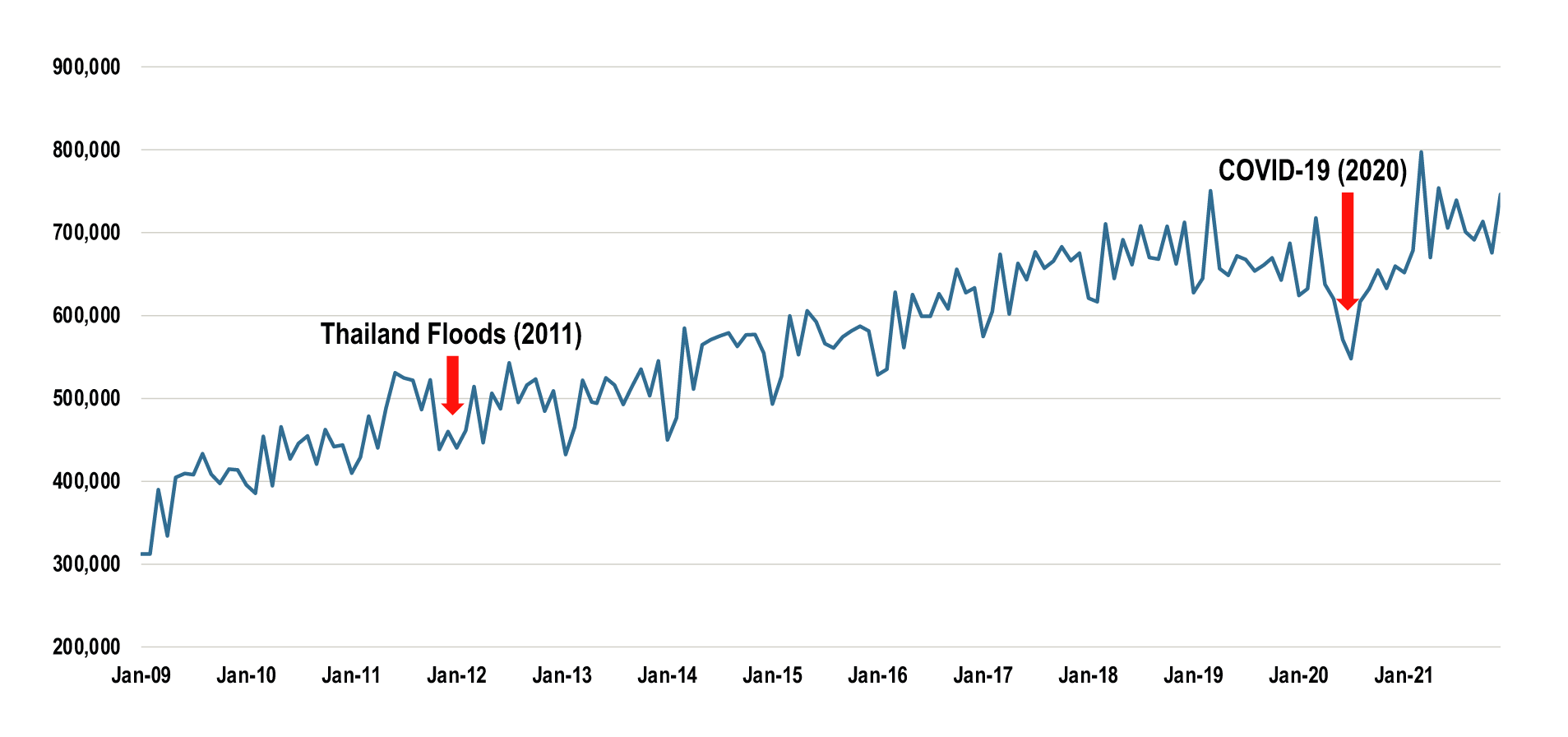Event: Floods, 2011
In July 2011, the Port of Laem Chabang faced a disruption caused by flooding which occurred at the confluence of the two downstream rivers that flow into the Chao Phraya River. The flooding reached the Bangkok area in October 2011 and persisted in some areas until mid-January 2012 (OCHA, 2011).
Causes and impact25
The flooding was mainly caused by an intense monsoon season characterized by seasonal flash-flooding, typical of tropical climate, which regularly occurs in northern Thailand and spread down the rivers flowing into the Mekong. Other amplifying factors exacerbated the disruption, including: (i) the continuously expanding infrastructure and construction standards (clay foundation rather than bedrock) are causing the Bangkok metropolitan area to progressively sink at a pace of up to three centimeters annually; (ii) sea-level rise; (iii) mismanagement of the dams upstream, the capability to take advantage of gentle slopes to control flooding of the Chao Phraya River was usually regarded as a good practice; (iv) bottlenecks on hinterland connections; and (v) higher tide levels in the Bay of Thailand in November, which prevented floodwaters to quickly flow out to sea.
The 2011 flooding in Thailand was described as one of the world’s costliest disasters (BBC, 2011), with the World Bank estimating economic damages and losses at $46.5 billion. In addition to the loss of life, several major industrial estates were inundated, causing a global shortage of rice, car parts and electronics, which disrupted various global value chains. Thailand was the second-largest producer of hard disk drives after China, which the computer industry is heavily dependent on as they serve as storage devices for computers and servers. Several factories were closed for more than a month, creating a scarcity of hard drives. In the inbound segment, many supply chains rely on a just-in-time principle, particularly since they are part of the same cluster. With short transport distances, inventory levels can be maintained at a low level with short cycle times. On the outbound segment, computer manufacturers usually have between 4-6 weeks of hard drive inventory. The area is an important car assembly and part manufacturing cluster, particularly for Japanese manufacturers attracted to the lower labour costs and available energy supplies to be found in Thailand.
Local manufacturing industries closed, which impacted port traffic. Hinterland infrastructure, including dry ports and transport links to the main ports, in particular roads, were disrupted. Railway embankments and inland waterways reported more limited damage. Meanwhile, the Port of Bangkok stopped receiving inbound containers due to yard congestion and container ships being rerouted to Laem Chabang. Thus, the latter suffered congestion due to the ripple effects of the Bangkok flood. The shortage of containers occurred as many of the inundated container terminals and ICDs had to stow laden containers above empties to avoid cargo damage.
Figure 43: Monthly traffic at the Port of Laem Chabang, 2009–2021

Source: Based on data from Bangkok Ship Owners and Agents Association (BSAA) http://www.thaibsaa.com/index.php/statistics.
The impacts of the floods on port traffic were noticeable (figure 43). Laem Chabang is the main port facility for Thailand and is situation about 125 km from Bangkok. Although the floods did not directly impact the port itself, it experienced a notable drop in traffic in November and December 2011. While January is the month of lowest activity; in the 2011 cycle November was the lowest month. On the positive side, the event took place at the onset of a period of low activity, giving the port room to handle the post-event demand surge. The expected low activity month (in January 2012) did not occur (AON Benfield, 2011).
Response and mitigation measures
Centralized flood monitoring and coordination began in mid-August. Public emergency intervention by the Thai government and Army, in cooperation with the Thai Red Cross and support from China, Japan, New Zealand and the United States. A 24/7 emergency operations centre was set up to coordinate warning and relief efforts. Inland water traffic was suspended for about 33 days at the peak of the flood.
Pre-event flood mitigation strategies included both structural (e.g. dikes and storage areas) and non-structural measures, such as diversion schemes and flood retarding areas. In many cases, structural solutions failed as flood walls broke in the prolonged flood. The case of Thailand underlines that for well-established logistics clusters, it takes substantial disruptions to incite mitigation measures involving relocation outside the cluster. Disruption inertia, a form of resilience, occurred. The preferred option is to improve the resilience of the cluster was through a series of strategic investments (APEC, 2011). In this case, the return on investment was facilitated by the fact that hard drives maintained their price for more than a year after the event. Port traffic was affected by the disruption but the main port’s infrastructure was not substantially impacted.
The Government of Thailand sought the support of Japan Disaster Relief for its drainage efforts (ten drain pump vehicles arrived at Laem Chabang at end of November). The Port of Laem Chabang responded by: (i) formulating longer-term strategic measures aimed at establishing better connectivity and regionalization; (ii) ensuring that it be directly and more densely connected with Singapore and other Asian economies, especially China; and (iii) increasing its market share of short-sea transport to reduce reliance on road transport, whose networks are often confronted by bottlenecks (JICA, Ibid).
Lessons learned and good practice26
- Monitor and assessment progress in terms of reconstruction efforts.
- Invest in a more climate-resilient infrastructure, including in relation to: (i) disaster risk management related to droughts, floods, and tropical storms; (ii) drainage capacity; (iii) maintenance of assets to improve efficiency and lifetime design; (iv) effective early warning systems; and (v) the review of critical flood embankments and dam safety.
- Strengthen port infrastructure through continuous improvement and maintenance.
- Enhance hinterland connectivity and ensure diverse transport connectivity options (Director, C. & Francois Bafoil).
- Implement digital solutions to cut the burden of bureaucratic and cross-border procedures.
